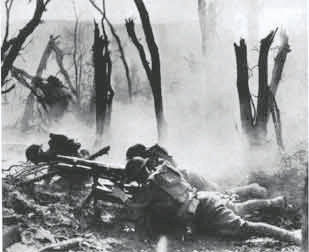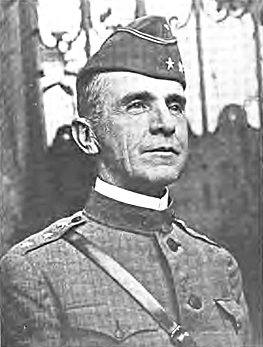BY NORMAN ROZEFF
It was a very unsettled period for the Valley. The reason for this unease was the ongoing revolution in Mexico that ran from the year 1910 into 1920 before matters were finally stabilized.
The year 1915 was one in which numerous cross-border incidents necessitated the stationing of U.S. Armed Forces, both regular Army and National Guard units that culminated in numbers over 100,000 in 1916 in the Lower Rio Grande Valley.
As the history of the 36th Division in the Texas Military Forces museum recounts, “Large portions of the Regular Army and the National Guard served in Mexico and on the border in 1916-1917. The nefarious raids of the Mexican revolutionary, Pancho Villa, particularly that against Columbus, New Mexico, in March, 1916, prompted the Wilson Administration to send the famous Punitive Expedition under Brigadier General John J. Pershing wheeling into Mexico in hot pursuit.
“To provide protection to the border inhabitants in the absence of the Regulars, President Wilson on May 9, 1916, ordered the National Guards of three Southwestern states into federal service. On June 18, owing to the growing resentment of Mexico against the deepening penetration of the Pershing expedition and to the threat of trouble with Mexican troops, the President called out the National Guards of other states. By July 4, the National Guards of 14 states were on duty in makeshift camps at their assigned border stations.
“The presence of 112,000 Guardsmen on the border by late July, 1916, undoubtedly discouraged serious incursions into the United States by border bandits. There were no major clashes and only a few Guardsmen ever crossed into Mexico. The primary value of the whole operation was not the protection of border citizens, but the training it provided the several Guards. The men were hardened physically and learned the fundamentals of soldiering in the field. Non-coms and officers gained valuable experience in handling men and in providing for their basic needs.
“Deficiencies and weaknesses in the Guard units were revealed and shortages of equipment and clothing were to some extent corrected by the army. As a result, those Guard organizations sent to the border in 1916 were partially equipped and trained when the United States entered World War 1.”
Soldiers of the 6th U.S. Cavalry, 26th Infantry, and the 3rd Texas National Guard were stationed in Harlingen as part of efforts to quell border unrest. The 3rd Texas Infantry arrived on May 9, 1916 and remained in Harlingen (and Donna) until September 7, 1916. They even have several field hospitals for the minimum of 12 companies involved here. The muster of Texas National Guard officers (158) and enlisted men (3,572) had begun on May 16, 1916 after which they were mobilized at Fort Wilson near San Antonio. It is now Fort Sam Houston.
Second and Third Regiments of Infantry and Field Hospital were stationed all along the Lower Rio Grande Valley from Harlingen to Roma. From about August 1914 Col. A. P. Blocksom was in charge of Valley forces but upon arrival of the 26th Infantry between August 1 and September 15, 1915 Col. Robert Lee Bullard took charge of forces in Harlingen and to the west.
Alabama native Col. Bullard’s military background was extensive. He was an 1885 graduate of the U.S. Military Academy at West Point and later served in various capacities in the Spanish-American War and then in the Philippines from 1902-04 after which he was made lieutenant colonel in 1906.
In 1907, he was special investigator for the U.S. provisional government in Cuba, and the following year was superintendent of public instruction there. In 1911, he was promoted to colonel. He was made lieutenant colonel in 1906. In 1907, he was special investigator for the U.S. provisional government in Cuba, and the following year was superintendent of public instruction there. In 1911, he was promoted to colonel. He served with the 8th Infantry on the Mexican Border (April-May 1911) and then attended the Army War College (1911-1912).
Assigned to the 26th Infantry in August 1912, he joined it in December in Michigan before it moved on to Texas. He mobilized and commanded the 4th Brigade, 2nd Division in Texas (most of time from February, 1913 to August, 1915). He remained in Texas through May 1917, seeing duty during the Mexican border troubles in 1916.
He won praise for his organizational skills before moving on to the commanding Officer’s Training Camp, Arkansas, May, 1917.
From Wikipedia we learn that after the American entry in World War I, Bullard was quickly promoted to brigadier general (June 1917) and major general N.A. (August 1917). He commanded the 1st Infantry Division (“Big Red One”) from December 1917 to July 1918.” Bullard was a favorite of John Pershing, commander of the American Expeditionary Force and its two armies.
When Pershing created the 2nd U. S. Army in October 1918 he selected Bullard to be its commander and elevated him to the rank of lieutenant general.
In a recently published book “Betrayal at Little Gibraltar” by William Walker, Bullard’s wartime actions are highly criticized. In September 1918 a planned offensive by combined Allied forces included nine American divisions sent into the valley between the Argonne Forest and the Meuse River.
Had Pershing’s offensive succeeded on its first day of attack, September 26, 1918, American troops “might have pierced critical defensive lines, severed railroads that fed the German front, and pinned a sizable German army against concerted French and British attacks.”
In short, taking control of the Sedan-Mezières railroad, Germany’s main supply link, was the Allied Force’s main objective. The American offensive failed. On September 30, Pershing called an end to the offensive.
Walker, among other historians, asserts that Bullard in a “breach of trust” was largely responsible for the subsequent losses, primarily in the 79th Division, which he was supposed to support with his 4th Division. Over 6.000 of the 79th were killed or wounded in the failed attempt to capture the craggy butte of Montfaucon that was a key German intelligence center.
Bullard, in abandoning the 79th to an unsupported frontal assault, instead drove his army to gainsay the dubious distinction of having advanced the farthest into German-held territory. While other historians hold Bullard’s chief of staff to blame, the change in orders leading to the debacle is not clear. Additional troops were added to the American forces that Pershing reorganized.
The campaign resumed on October 4. The goal was to reach the Meuse River and break the German lines entirely. The Americans crossed the river on November 4 and the Germans surrendered on November 11, 1918. The price of this victory, the war’s greatest engagement, was very high; the Americans had 26,277 killed, with another 95,786 wounded. The Germans, who had far fewer troops in the campaign, had 28,000 killed and 92,250 wounded.
Bullard’s character and frame of mind in such matters is made clear by yet another controversial action. With full knowledge that the Armistice was due in a few hours, Bullard sent his troops into battle. This incident is recounted in Alden Brook’s “As I Saw It” (1930).
Bullard reverted to his permanent rank of major general in June 1920 and retired from active duty in 1925. He died September 11, 1947 and is buried with his wife in the U.S. Military Academy Post Cemetery. His action at the Meuse-Argonne, where the new technologies of machine guns and poison gas decimated so many, will always remain a somber footnote to his long military career.





